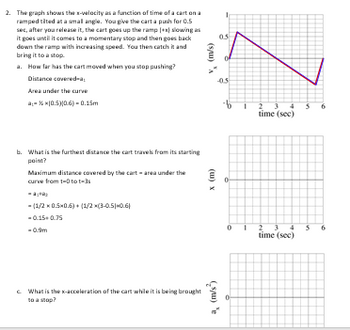
College Physics
11th Edition
ISBN: 9781305952300
Author: Raymond A. Serway, Chris Vuille
Publisher: Cengage Learning
expand_more
expand_more
format_list_bulleted
Concept explainers
Topic Video
Question
thumb_up100%
only need help in d and e

Transcribed Image Text:X acceleration - tane
-(0.6)/(6-5.5)
-1.2m/sec²
d. What is the x-acceleration while the cart it is going up and
down the ramp without you touching it?
e. Make rough graphs of the x and avs. time for the motion.
You don't have to get everything precisely but make sure
portions that are curved are curved, portions that are straight
are straight, and portions that are flat are flat. Include
numbers on the vertical axes to set the scale.

Transcribed Image Text:2. The graph shows the x-velocity as a function of time of a carton a
ramped tited at a small angle. You give the carta push for 0.5
sec, after you release it, the cart goes up the ramp [+x) slowing as
it goes until it comes to a momentary stop and then goes back
down the ramp with increasing speed. You then catch it and
bring it to a stop.
a. How far has the cart moved when you stop pushing?
Distance covered-a
Area under the curve
-% (0.5)(0.6)-0.15m
b. What is the furthest distance the cart travels from its starting
point?
Maximum distance covered by the cart-area under the
curve from 1-0 tot-3s
-(1/2 x 0.5*0.6) + (1/2 x(3-0.5*0.6)
-0.15+0.75
-0.9m
What is the x-acceleration of the cart while it is being brought
to a stop?
(spu) A
(w) x
(sau)
-0.5
b1 2 3 4 5 6
time (sec)
234
time (sec)
5
Expert Solution
This question has been solved!
Explore an expertly crafted, step-by-step solution for a thorough understanding of key concepts.
Step by stepSolved in 4 steps with 5 images

Knowledge Booster
Learn more about
Need a deep-dive on the concept behind this application? Look no further. Learn more about this topic, physics and related others by exploring similar questions and additional content below.Similar questions
- The normal acceleration of an object moving along a curved path. (Select all that are correct) O proportional to radius of curvature. O represents the rate of change in the magnitude of the velocity. represents the rate of change of the velocity vector's direction. O is inversely proportional to the radius of curvature.arrow_forwardPredict the direction of force in each numberarrow_forward
arrow_back_ios
arrow_forward_ios
Recommended textbooks for you
 College PhysicsPhysicsISBN:9781305952300Author:Raymond A. Serway, Chris VuillePublisher:Cengage Learning
College PhysicsPhysicsISBN:9781305952300Author:Raymond A. Serway, Chris VuillePublisher:Cengage Learning University Physics (14th Edition)PhysicsISBN:9780133969290Author:Hugh D. Young, Roger A. FreedmanPublisher:PEARSON
University Physics (14th Edition)PhysicsISBN:9780133969290Author:Hugh D. Young, Roger A. FreedmanPublisher:PEARSON Introduction To Quantum MechanicsPhysicsISBN:9781107189638Author:Griffiths, David J., Schroeter, Darrell F.Publisher:Cambridge University Press
Introduction To Quantum MechanicsPhysicsISBN:9781107189638Author:Griffiths, David J., Schroeter, Darrell F.Publisher:Cambridge University Press Physics for Scientists and EngineersPhysicsISBN:9781337553278Author:Raymond A. Serway, John W. JewettPublisher:Cengage Learning
Physics for Scientists and EngineersPhysicsISBN:9781337553278Author:Raymond A. Serway, John W. JewettPublisher:Cengage Learning Lecture- Tutorials for Introductory AstronomyPhysicsISBN:9780321820464Author:Edward E. Prather, Tim P. Slater, Jeff P. Adams, Gina BrissendenPublisher:Addison-Wesley
Lecture- Tutorials for Introductory AstronomyPhysicsISBN:9780321820464Author:Edward E. Prather, Tim P. Slater, Jeff P. Adams, Gina BrissendenPublisher:Addison-Wesley College Physics: A Strategic Approach (4th Editio...PhysicsISBN:9780134609034Author:Randall D. Knight (Professor Emeritus), Brian Jones, Stuart FieldPublisher:PEARSON
College Physics: A Strategic Approach (4th Editio...PhysicsISBN:9780134609034Author:Randall D. Knight (Professor Emeritus), Brian Jones, Stuart FieldPublisher:PEARSON

College Physics
Physics
ISBN:9781305952300
Author:Raymond A. Serway, Chris Vuille
Publisher:Cengage Learning

University Physics (14th Edition)
Physics
ISBN:9780133969290
Author:Hugh D. Young, Roger A. Freedman
Publisher:PEARSON

Introduction To Quantum Mechanics
Physics
ISBN:9781107189638
Author:Griffiths, David J., Schroeter, Darrell F.
Publisher:Cambridge University Press

Physics for Scientists and Engineers
Physics
ISBN:9781337553278
Author:Raymond A. Serway, John W. Jewett
Publisher:Cengage Learning

Lecture- Tutorials for Introductory Astronomy
Physics
ISBN:9780321820464
Author:Edward E. Prather, Tim P. Slater, Jeff P. Adams, Gina Brissenden
Publisher:Addison-Wesley

College Physics: A Strategic Approach (4th Editio...
Physics
ISBN:9780134609034
Author:Randall D. Knight (Professor Emeritus), Brian Jones, Stuart Field
Publisher:PEARSON